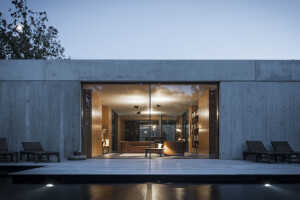Skype’s primary goal was to create a world-class o!ce that would di"erentiate them from their Bay Area competitorsin the recruitment of talent. Their new space not only had to be a design statement that reflected their modern but funpersonality, but it also had to meet very specific acoustic requirements to support the company’s extensive use of AV.Skype hired Design Blitz architects to design their new North American headquarters on an aggressive budget andschedule.
To really understand how Skype operates culturally, Design Blitz undertook extensive user-group surveying, andresearched workspace typology before ever laying pen to paper. A significant portion of Skype’s culture is built aroundScrum development (iterative idea generation) and a philosophy called ‘Agile Thinking’ (the a"ect of environment onthought process). To support Scrum, Blitz designed a system of mobile white boards called Skype-its that aredistributed throughout the project. They can be easily moved and stored depending on a development team’s processand requirements. Blitz also created a multitude of di"erent environments to support di"erent thought processes. Allof the casual meeting areas are unique and there are three distinct phone booth types: light and bright for activethought; medium colored for meditative thought; and dark cave-like rooms for introspective thought.
Like many organizations, Skype required three distinct types of spaces: collaboration, contemplation and concentrationspaces. Since Design Blitz believes that people, not conference rooms, deserve natural light, the architects tookadvantage of the exterior windows and located all workstations at the building perimeter (concentration). They thenworked their way back to the middle by degree of noise and distraction, with the noisiest functions being at the middleof the space (collaboration). Meeting rooms and phone booths were prioritized as no member of sta" had a privateo!ce (an open floor plan with a benching workstation system was implemented). Contemplation spaces wereinterspersed in the form of overlapping casual lounges.
With such large floor plates it was important for users to be able to orient themselves. The project is organized along acentral highway with various nodal meeting spaces to convey a sense of location, while also encouraging workers toliterally meet-in-the-middle. This becomes even more critical given the international, transient nature of the Skypeworkforce.
The building itself provided the greatest source of design inspiration. It was a dark and dingy space with years of tiredtenant improvement projects layered on top of one another. It stood vacant for quite some time while neighboringbuildings were being leased within weeks. While touring the site, Blitz popped out a few ceiling tiles and theopportunity to strip away the layers and reveal the existing structure became immediately apparent. The architectsmade a decision to rip out all the existing ceilings and furring around the steel and never looked back. The resultingspace is raw, industrial, and suggestive of a warehouse, which stands in perfect contrast to the highly refined meeting room pods that Blitz inserted into the open space.
The pods house the meeting and collaboration function and require a very high level of acoustic attenuation (farexceeding typical TI construction). To achieve the aesthetic of a floating pod (the pods are self-supporting) andachieve Skype’s acoustical requirements, Blitz had to develop a unique building typology. The architects utilized astructural roof deck, commonly used in large span construction, that provided them with the structural diaphragm overthe pods, provided a high level of acoustic attenuation, and also functioned as the finished ceiling. This multi-functionquality was a key focus throughout the project - one item fulfilling multiple functions.
With a tight budget, Design Blitz had to be creative and use simple, ordinary materials in new and creative ways. In thechill-out area they clad one wall with astroturf, and another with industrial felt. These coverings function as soundattenuation and finish materials, but also a"ord a little whimsy. At the Skype-it niches the architects used common3/4” birch plywood and sized the niches to fit standard material modules. The plywood provides a high STC rating andis also the finish material. The Board Room is clad in wine flavor sticks, found at a salvage yard. These provide a uniquefinish to this particular pod and subtly celebrate California - an important program element for Skype.
Despite being one of several new o!ces this year for Skype, this project has been identified as the standard for theinternational communications company. It also achieved LEED Silver certification.



































